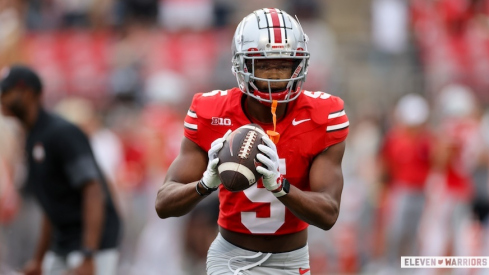
The Ohio State defense turned in its best performance of 2013 in the Buckeyes' 63-14 victory.
While the first team defense did surrender some yards, they held Penn State to one touchdown and made critical stops. More importantly they consistently pressured freshman quarterback Christian Hackenburg, making him uncomfortable and forcing him to hurry throws.
The Buckeyes' defensive improvement was not a result of wholesale changes. Rather the Ohio State coaching staff adjusted at the margins to produce a more aggressive, fundamentally sound unit.
The Buckeye defense also benefited from better execution. Nowhere was this more apparent then with Noah Spence and CJ Barnett, who played their best games of the season.
Below I address Ohio State's scheme adjustments, responses to common offensive techniques against the Buckeye defense, and execution at critical positions.
Get Ready Because here it comes
Penn State picked up right where Iowa left off, immediately placing two tight ends to the boundary. The Buckeyes made several adjustments to better defend the offense's numbers' strength to the short field. Tommy Schutt, returning from a broken ankle, started at nose guard. The coaching staff shifted the nose towards the boundary, moving him from a one technique to the boundary to align face up on the center or as a zero shade. This provided an additional defender who could get across the centerline.
Strong safety Barnett, meanwhile, was brought down over the tight end. The two changes provided sufficient defenders to combat Penn State's numbers to the boundary.

These type of subtle adjustments were evident throughout. The Buckeyes altered when they used particular coverages. On first and second down the Buckeyes aligned in a quarter-quarter half shell. This put Barnett in the aforementioned position over the tight end. From there, the Buckeyes used one of two looks. The first was quarter-quarter-half, meaning that to the boundary Roby and Barnett played cover 2, while to the wide side Doran Grant and Corey Pitt Brown played cover 4. This put Roby in force support to the boundary, again helping against the short side run game.
Alternatively, the Buckeyes would play cover 1. From the pre-snap alignment, Roby and Barnett were in a position to cover the first and second receiver to their side. Brown would simply rotate over to the middle of the field. The adjustment was easy for the defense but sufficient to sew doubt for Hackenberg.


TIghtening the screws
Up front, the defensive coaching staff did not drastically alter how often the Buckeyes blitzed. The changes were more incremental. The Buckeyes slightly increased their pressure, but more importantly changed the variety of blitzes. They brought six man pressures with Curtis Grant and Ryan Shazier, but also nickel and corner blitzes with Tyvis Powell and Roby.
More noticeable was the increase in stunting from the defensive line. To further combat the boundary heavy run formations the Buckeyes often slanted their defensive line to the boundary.
The critical difference, however, was the sizeable increase in pass rush from the Buckeye defensive ends. The coaching staff largely eschewed three man rushes to bring pressure from each edge. Many of Ohio State's pressures on Hackenberg were from four man rushes. In cover 1 the linebackers were then given freedom to delayed blitz if the running back stayed in to block.

Noah Spence and Jamal Marcus were particularly effective as edge rushers. It was Spence's best performance as a Buckeye and a bounce back from inconsistent play against Iowa.

Spence was also put in a better position to succeed. He was deployed as a typical defensive end rather than as a hybrid linebacker with frequent pass coverage responsibilities. This seemed to allow him to get in a rhythm as a pass rusher.
But Spence was also much improved in a less heralded aspect, namely setting the edge against the run. Unlike Iowa, he consistently maintained outside leverage and held his position.
The Buckeyes also received a crucial performance from Barnett. Barnett has always been strong against the run but inconsistent in coverage. But he did an excellent job against Penn State's tight ends, particularly against seam routes, where he would divert and carry them down the seam, leading to his interception.
It is difficult to see the Buckeye defense move away from this formula. In particular, look for the Buckeyes to consistently use Spence and Marcus as bookends in passing downs, as it provides Ohio State two edge rushers an offense must account for.

